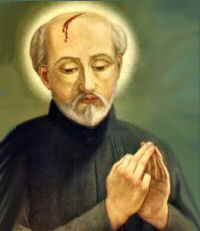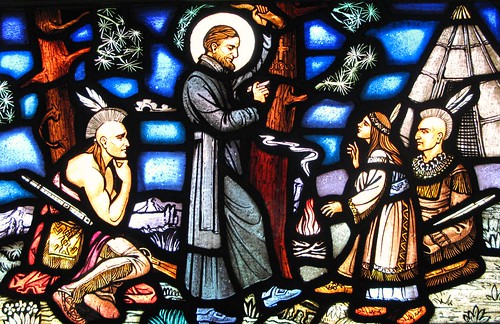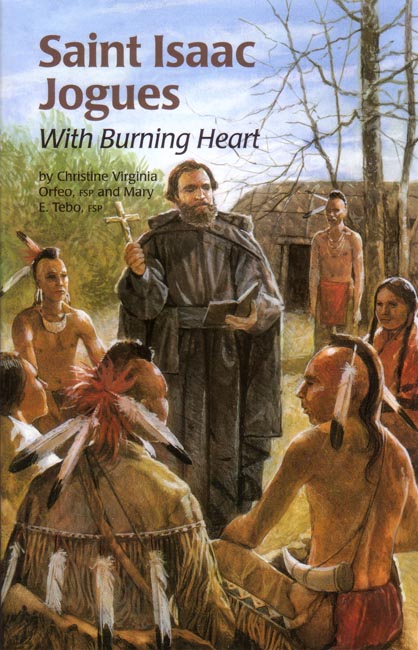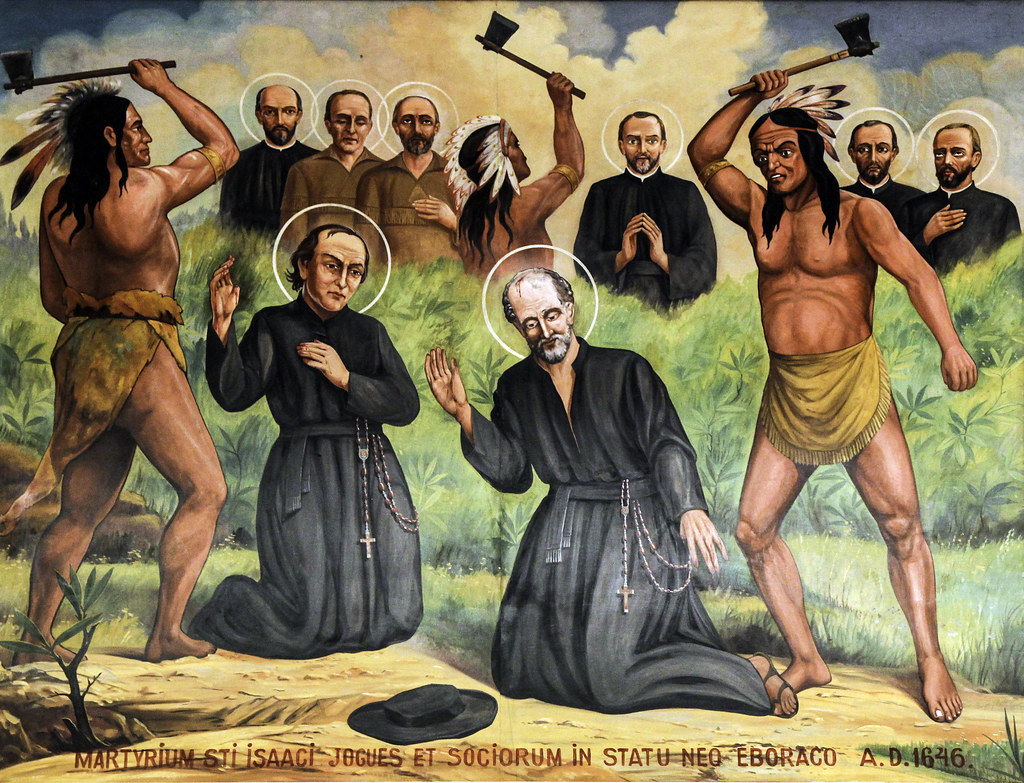St Isaac Jogues, SJ
Born : Jan10, 1607
Died : Oct 18, 1646
Beatified : June 21, 1925
Canonised : June 29, 1930
 Issac Jogues was born in Orleans, France. At seventeen, he entered the Jesuit novitiate in Rouen, did his philosophy at La Fleche and theology at Clermont College in Paris. He was ordained in January 1636, and in April went to the Jesuit mission in New France. On his arrival in July, he wrote his mother of the joy he experienced when he first glimpsed the natives waiting on the shore – it was so great that he thought he was entering Paradise.
Issac Jogues was born in Orleans, France. At seventeen, he entered the Jesuit novitiate in Rouen, did his philosophy at La Fleche and theology at Clermont College in Paris. He was ordained in January 1636, and in April went to the Jesuit mission in New France. On his arrival in July, he wrote his mother of the joy he experienced when he first glimpsed the natives waiting on the shore – it was so great that he thought he was entering Paradise.
Fr Jogues was assigned to the Huron mission. In his first mission to Huronia, he had to trek nine hundred miles by water. The Huronian Indians nicknamed him “Ondessonk” or “Bird of Prey” because they could not pronounce his name. In Huron, Fr Jogues met his hero, Fr John de Brebeuf and learnt the Huron language. He went to Sainte-Marie which was a thriving village. Here he instructed the Indians how to cultivate the land, tend the crops and care for children, pigs and cattle. When Sainte-Marie became prosperous, the tribes invited the priests to establish a mission among them. The mission was committed to evangelizing the Huron. Fr Jogues spent the winter and spring of 1642 at Sainte-Marie preparing his neophytes for baptism and converted 120 adults in Easter, including the tribe’s greatest war chief.
 Although the Jesuits felt that Christianity was beginning to take root, Fr Jogues longed for a greater harvest, the conversion of the entire Huron nation, even if it meant more suffering on his part. One day, while praying for the desire to sacrifice himself for the conversion of the Huron, he heard the words: “Be it done to you as you asked. Be comforted! Be of strong heart!” and knew that God had accepted the sacrifice of himself and this was a prophecy of what was to come. The Iroquois were at war with the French and Fr Jogues understood the dangers he faced when he and Rene Goupil, a surgeon and lay assistant, who promised to work with the missionary without pay and to live a celibate life, were ambushed by seventy Mohawks and brutally tortured and taken to the village of Ossernenon.
Although the Jesuits felt that Christianity was beginning to take root, Fr Jogues longed for a greater harvest, the conversion of the entire Huron nation, even if it meant more suffering on his part. One day, while praying for the desire to sacrifice himself for the conversion of the Huron, he heard the words: “Be it done to you as you asked. Be comforted! Be of strong heart!” and knew that God had accepted the sacrifice of himself and this was a prophecy of what was to come. The Iroquois were at war with the French and Fr Jogues understood the dangers he faced when he and Rene Goupil, a surgeon and lay assistant, who promised to work with the missionary without pay and to live a celibate life, were ambushed by seventy Mohawks and brutally tortured and taken to the village of Ossernenon.
Later, they were given as personal slaves to the chiefs but Rene was later tomahawked to death by a brave when he made the sign of the cross on a child. Fr Jogues lived out his months of slavery and was exposed to the most demeaning and degrading work. However to the captive Christian Hurons, he was still their priest and to these he continued to bring the consolation of the faith. He managed to escape to present day Albany in 1643 and was put on a ship to France.
 Fr Jogues landed in Brittany on Christmas morning in 1643 and was received by his Jesuit brethren as a hero, as if a martyr had returned to life. Fr Jogues’ regret was his inability to celebrate Mass because of his mutilated hands. He had no left thumb and the index finger on his left hand was a stub whilst his right thumb and index finger were badly disfigured. With such mangled hands, he was unable to hold the host correctly. But his brethren requested a dispensation of Pope Urban VIII, who most willingly granted it with the memorable words: “It would be shameful that a martyr of Christ be not allowed to drink the blood of Christ.”
Fr Jogues landed in Brittany on Christmas morning in 1643 and was received by his Jesuit brethren as a hero, as if a martyr had returned to life. Fr Jogues’ regret was his inability to celebrate Mass because of his mutilated hands. He had no left thumb and the index finger on his left hand was a stub whilst his right thumb and index finger were badly disfigured. With such mangled hands, he was unable to hold the host correctly. But his brethren requested a dispensation of Pope Urban VIII, who most willingly granted it with the memorable words: “It would be shameful that a martyr of Christ be not allowed to drink the blood of Christ.”
Fr Jogues however, yearned to return to his mission which he did in 1644 after he visited his mother in Orleans. He arrived in June and in July, attended the peace conference at Three Rivers between the French and the Indians, representing the Iroquois Federation. The conference lasted several months and peace terms were finally drafted. But before a final settlement could be made, the conference needed the approval of the Mohawks as well. Fr Jogues was chosen as envoy to obtain their consent and left for Ossernenon in May 1646. When he arrived in June, the Mohawks were amazed that their former slave now came as the ambassador of the powerful French nation. Fr Jogues offered them the gifts of the French government and explained the terms of the treaty, which they accepted. Before departing the village, he visited the few Christian Huron prisoners remaining there, heard confessions and baptised some elderly Mohawks.
Fr Jogues returned to Quebec and thinking that the Mohawks would accept him as a missionary now that peace had been agreed upon, asked permission of his superior to return to them. He was told to wait at Three Rivers and to wait for some exceptional opportunity. That opportunity came in September when the Hurons asked Fr Jogues to lead them to arrange the details of the treaty. Fr Jogues wrote to France before he left. He wrote: “I shall go, but I shall not return. It will be happiness for me, if God will be pleased to complete the sacrifice there where he began it.”

Fr Jogues was accompanied by John de La Lande, who volunteered to devote his life to the service of God and to work with the missionaries, as his assistant and several Hurons and left Quebec on September 24, 1646. Shortly after, they learnt that the Mohawks were again on the warpath the frightened Hurons in the party left to return to the Three Rivers, leaving the two missionaries and one Indian. The death-seeking Mohawks unexpectedly came upon Fr Jogues and his party and cut strips of flesh from the neck and arms of Fr Jogues. The following day, while being led to the chief’s lodge for a feast, he was killed when he was struck on the head with a tomahawk and his body was dragged through the village. John de La Lande, when told of Fr Jogues’ death, was trying to find his body, too was tomahawked to death. Fr Jogues and John de La Lande, together with six others, were the eight North American martyrs who were canonized in 1925.
